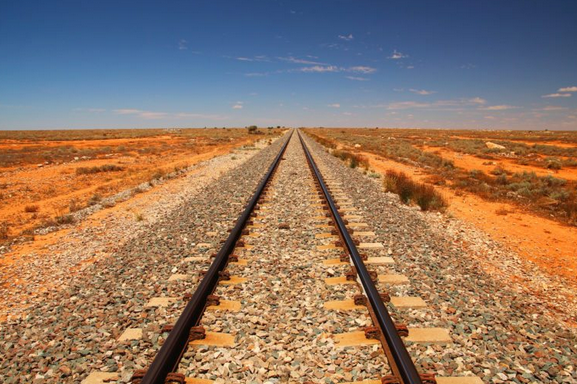
By Federation, in 1901, all States, except Western Australia, were linked by rail. Sadly, those who envisaged a nation had not contemplated a national rail network. Three different gauges had been used. —History of Rail in Australia
After retiring from British politics, Michael Portillo began narrating a collection of travel programs for the BBC, following George Bradshaw’s nineteenth-century railway guide. I reviewed his series Great British Railway Journeys in the September 2018 issue.
Bradshaw (below, at right) a Quaker, was born in Lancashire in 1801, and became a cartographer. The Bradshaw guide was legendary in its day, and was later expanded to include international railways. In 2019, using Bradshaw’s Through Routes to the Chief Cities and Bathing and Health Resorts of the World: A Handbook of Indian, Colonial, and Foreign Travel, Portillo visited Australia to travel our railways in the series Great Australian Railway Journeys. It was first broadcast on BBC2 in 2019, and aired in Australia on SBS this year.
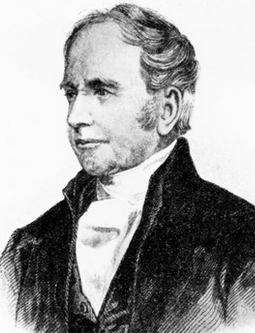 I managed to locate the 1913 Bradshaw international edition, but only as a photographic facsimile, printed in India. Bradshaw wrote: “A voyage to Australia is frequently recommended as an excellent means of recruiting health and strength.”
I managed to locate the 1913 Bradshaw international edition, but only as a photographic facsimile, printed in India. Bradshaw wrote: “A voyage to Australia is frequently recommended as an excellent means of recruiting health and strength.”
In the first episode, Michael Portillo takes the Port Augusta-to-Darwin line, known as The Ghan. The route started in 1878, with strong political motivation to link Darwin to South Australia for economic reasons, but the depression of 1891-92, extreme hot climate and floods halted construction. It took a century from the time Bradshaw’s Guide was first published before the line was finally completed. Portillo remarks that “medieval cathedrals were built faster”. The Ghan, short for “The Afghan Express”, was named after the camel trains introduced in the 1860s by Thomas Elder, a landowner. Before the separate national railways connected, camels were frequently required to transport goods between the different lines and many of the cameleers were Afghan.
The Ghan is a high-end luxury travelling experience, but Portillo chose to make the first leg of the journey, Adelaide to Alice Springs, on the Pichi Richi Heritage Railway, the only remaining part of the original Ghan line still in operation. He disembarks at Alice Springs and meets members of the Arrernte people, learning about bush tucker and dreamtime stories. Portillo is refreshingly unhesitant about diving head-first into the issues of Aboriginal history and “lost generations”.
Joe Dolce’s column appears in every Quadrant
For the journey to Darwin, he transfers to the modern Ghan: one kilometre long, with thirty-eight carriages, two locomotives, three power vans, four kitchens, five restaurants, five bars and nineteen bedroom cars, and is surprised by an entire restaurant car filled with local Portillo fans, who invite him to judge “The Most Michael Portillo-like Competition”. Christopher Stevens of the Daily Mail was particularly moved by this incident:
The charismatic, square-jawed rebel leader is surrounded by his faithful followers, all claiming to be him. No, it isn’t Kirk Douglas in Spartacus, but Great Australian Railway Journeys (BBC2). “I’m Portillo!” cry the devoted disciples, clad in salmon pink and canary yellow while brandishing their Bradshaw’s guides. “I’m Portillo! I’m Michael Portillo!” By sheer coincidence, as Michael boarded the Ghan express to roll across the Northern Territory … a band of dedicated Portillistas and their wives were embarking, too. They all sported cravats, floral shirts, Technicolor chinos and luminous jackets, in tribute to their travelling hero.
The Ghan makes a stop in Katherine, where a local guide takes Portillo down the Katherine River. Portillo tactfully omits some of the more disparaging remarks about Aborigines from Bradshaw’s Guide, but does quote: “It would appear that their numbers were never large, and that the life led by them was, in many parts of the country, a most precarious one.” Portillo’s Aboriginal guide disagrees, and illustrates the ingenuity and self-sufficiency that locals have always possessed.

I think Portillo was a bit embarrassed by Bradshaw’s stereotyping and is overcompensating here with a little too much of the “noble savage” view of indigenous Australia. But he is a fair person and, on arrival in Darwin, he respectfully attends one of Australia’s largest Anzac Day celebrations. He closes with the theme of remembrance: of the traditional pioneers of contemporary Australia—the soldiers, the cattlemen and the railroad pioneers—and of the significance of Aboriginal culture.
In episode two, Portillo travels from Sydney to Broken Hill, after spending the first half of the program exploring Sydney. He draws a comparison between Australia and China, “roughly the same area, but with only 24 million people, contrasted with China’s 1.4 billion” and declares, “the growth of Australia has hardly begun”.
Portillo takes us to Hyde Park Barracks, built to house transported prisoners, and designed by the English-born architect Francis Greenway, transported to Australia himself for forgery. On the practice of transportation, Portillo wryly comments: “seems like an awful long way to come to do your porridge”. He visits Darling Harbour and boards a replica of Captain Cook’s Endeavour, sharing with us Cook’s “secret orders” from England: “to seek a continent, or land, of great extent, and claim it for Great Britain”.
On Bondi Beach, Portillo learns some lifesaving skills from the Bondi Surf Bathers Life Saving Club, established in 1907. The Waverley Council did not allow bathing on Bondi Beach during daylight hours until 1905, when bathing suits had to be neck-to-knee for both men and women.
Portillo travels two hours into the Blue Mountains to Katoomba, where he rides the Scenic Railway, previously built as a coal train, and now converted for tourists. It is the steepest railway in the world.
Back in Sydney, he boards the Indian Pacific bound for Perth. Before 1970, passengers travelling across Australia had to change trains five or six times due to differently-gauged tracks, but now a single train makes the entire journey. Spending the night in a sleeper with Bradshaw’s Guide in hand, Portillo comments, “I find that nothing induces sleep quite as much as reading Bradshaw.” During the Gospers Mountain bushfire in October 2019, the International Railway Journal reported that “with one major exception, the rail industry has escaped largely unscathed”. Sections of the Indian Pacific had to be re-routed and 200 trees along the line cut down.
The train makes a stop in Broken Hill, which in 1883 was the centre of Australian silver mining wealth—but without a “silver rush”, owing to its remoteness. Silver miners suffered from lung diseases from the mica in the earth, and were prescribed opium to relax the lungs and advised to “drink large amounts of whisky”. Silver remains the area’s primary export, but solar power is a rising industry, the 140-hectare Broken Hill Solar Project supplying power to 20,000 homes. Portillo says Broken Hill “must live from exploiting natural resources, in the future, as in the past”.
In episode three we continue on the Indian Pacific, travelling from Adelaide to Perth. Portillo admires Adelaide, originally designed to be a “perfect capital” in a square grid surrounded by parkland, aiming to be a utopia for free settlers.
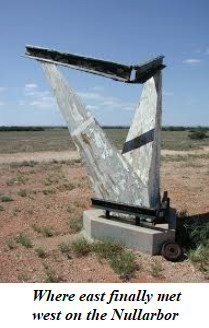 The Indian Pacific then proceeds thirty hours to the mining town of Kalgoorlie. In 1901, all states had been linked by rail, except Western Australia. There remained a 1000-mile gap between Kalgoorlie and Port Augusta and, in 1912, teams set out from each end to lay a track, taking five years to meet up owing to the First World War and the primitive tools of the day: picks, axes, shovels and camels. There was also the challenge of the Nullarbor Plain (from the Latin nullis arbor—no trees), comprising one of the largest limestone plates in the world. The finished route included the longest stretch of straight railway in the world: 300 miles.
The Indian Pacific then proceeds thirty hours to the mining town of Kalgoorlie. In 1901, all states had been linked by rail, except Western Australia. There remained a 1000-mile gap between Kalgoorlie and Port Augusta and, in 1912, teams set out from each end to lay a track, taking five years to meet up owing to the First World War and the primitive tools of the day: picks, axes, shovels and camels. There was also the challenge of the Nullarbor Plain (from the Latin nullis arbor—no trees), comprising one of the largest limestone plates in the world. The finished route included the longest stretch of straight railway in the world: 300 miles.
Gold was discovered in Kalgoorlie in 1893, creating a gold rush. Investment for the larger mines came quickly from Great Britain, as 2000 people a week began arriving, seeking their fortunes. The influx necessitated a 330-mile water pipeline to be built from Perth over the Darling Ranges.
Before leaving Kalgoorlie, Portillo visits the Royal Flying Doctor Service, founded in 1928. Their small planes are outfitted to be “intensive care in a telephone box”, bringing the “hospital to the patient”.
Portillo travels to Pinjarra, and talks to locals about the Fairbridge Scheme. In 1909, Kingsley Fairbridge founded the Society for the Furtherance of Child Emigration to the Colonies, to ease pressure on British orphanages, with the idea of moving English children from the squalid overcrowded conditions of London to a better environment in Australia. Portillo interviews a man raised under the program, who admits to Portillo that there was a total absence of love from staff—“it just didn’t exist”—but acknowledges that, for him, as a destitute orphan, it was certainly worth it. He adds that the scheme was a horrible experience for many of his childhood mates; another former resident, interviewed by Portillo, refuses to discuss what happened to him. The Fairbridge Scheme was later discredited for physical and sexual abuse of minors.
In the fourth episode, Portillo travels from Canberra to Melbourne. Taking a balloon ride over Canberra, he exclaims, “I’m in a large picnic basket. Am I sane?” From the air, he ponders the city’s “master plan”, like those of Paris and Washington. Rivalry in the nineteenth century between New South Wales (the mother colony) and Victoria (recently rich from gold) prevented either from accepting the other as the natural site for a capital, so a new city was formed. Originally, politicians argued over the pronunciation: CAN-berra or Can-BERRA, but they agreed that whatever pronunciation Lady Gertrude Mary Denman, the British feminist and wife of Lord Denman, the Governor-General, used at the 1913 official launch would be the one. She chose the former. Portillo, the former politician, is fascinated by Parliament House, and says, “With its rough-and-tumble, it’s like Westminster with an Australian accent.”
He arrives in Melbourne, noting that the discovery of gold, and waves of immigration, formed the city’s unique character, populated by free settlers, not convicts. Portillo declares it the “cultural and sporting capital of Australia”, with a succinct physical description:
[a] large number of older buildings of British style, and then it’s as though someone had come along and grafted onto that a modern downtown of American-style skyscrapers—but … the graft didn’t take. The place still feels really European.
Melbourne, even in Bradshaw’s day, was known for its “fine coffee palaces”, but after the Second World War, Italian immigrants made Melbourne’s “coffee culture … the greatest in the world … favouring local names and cafes and spurning multi-nationals”.
Portillo goes to Jolimont, home of the Melbourne Cricket Ground, established in 1853, calling it one of the world’s most famous arenas, noting that it “fills the role of the medieval cathedral in the life of the city”. He stresses the importance of cricket in early Australia, when, in 1877, twenty-four years before Federation, colonial cricketers from New South Wales and Victoria came together for the first time as one team to play against England. Politicians attending the game were inspired by the vision of a unified Australia on the playing field.
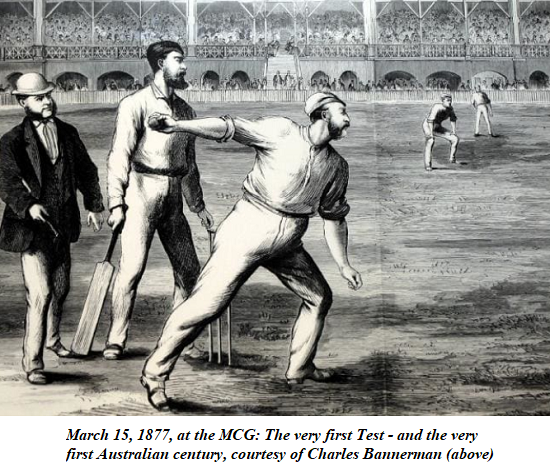
In St Kilda, he attends a private screening at the Astor Theatre of the 1906 film The Story of the Kelly Gang, the world’s first feature-length movie, about Australia’s most “likable rogue”. From Flinders Street station he takes a local train to Dame Nellie Melba’s Coombs Cottage in Lilydale, built in 1912, with seven acres of garden, and still owned and run by the family. On the grounds he samples a Peach Melba, the famous dessert created by the French chef Auguste Escoffier. Strangely, he is served a modern deconstruction of it, which doesn’t resemble Escoffier’s classic dish at all.
After taking a local train to Belgrave, he rides the popular narrow-gauge “Puffing Billy” heritage train, originally built in 1900 to service the timber business. The train stopped running in 1953 after a landslide blocked a section of the track, but the Belgrave section was reopened in 1962 by the Puffing Billy Preservation Society.
In episode five, Portillo travels from Cairns on the Kuranda Scenic Railway. Through rainforest and past massive stone-cliff waterfalls, he crosses the Stoney Creek Bridge, built on steel pylons hundreds of feet above the Barron Gorge. The line to Kuranda was built in 1886, more than 1500 Irish, Italian and Chinese workers labouring to construct the fifteen tunnels and thirty-seven bridges. Twenty-three of the workers died from explosive accidents, avalanches and falls. Tourists first started coming in 1891 for the “wellness air”.
Portillo returns to Cairns, originally built for miners heading for goldfields and developed as a port and a rail head, and boards the Spirit of Queensland, southwards to Brisbane. The train stops in Innisfail, which was established by a sugarcane farmer. A ferocious cyclone in 1918 wiped out every building except two, and a decision was made to rebuild the entire town in the Art Deco style of the twenties.
The Spirit of Queensland continues on to Townsville. There’s a sign on the platform: “Warning. Plastic snakes on station to deter birds”. Portillo laughs: “Only in Australia!”
He takes us to the Great Barrier Reef, “the only living thing on earth visible from space, extending 1400 miles, and made up of 3000 separate reefs; the whole being as large as Germany”. Portillo believes that global warming threatens the reef, as rising water temperature encourages the spread of a creature which is destroying it: the crown-of-thorns starfish. One starfish can consume thirteen square metres of reef a year and each female can lay 60 million eggs in a single spawning season. The “RangerBot” robot, an aquatic drone, has been developed to find these starfish and deliver an injection that kills them.
Episode six has Portillo travelling the XPT line along the coast from Sydney to Newcastle. In 1887 the line was known as the “Short North”. As he crosses the Hawkesbury River Bridge, he tells us that, in Bradshaw’s time, trains had to stop on one bank, and the passengers crossed on a paddle steamer and connected with another train on the opposite bank.
Portillo says, “Newcastle is the world’s largest coal exporting port in the world’s largest coal exporting country.” Located at the mouth of the Hunter River, the town was built by convict labour and feared as the “hellhole”—where the most dangerous criminals were sent to work in the mines. He visits the staggering production facility of Newcastle Coal, “one port exporting more coal than Britain produced fifty years ago”—160 million tonnes annually. At Fort Scratchley (below in 1903), built to defend against a possible Russian attack in the 1880s, he notes that its two six-inch field guns were first used against Japanese submarines in the Second World War.

Transferring to the North Coast Line, Portillo shares a humorous moment chatting with a teenager who is only riding the train because he missed his flight. Portillo asks him if he is “anti-train”, but the boy dumbfounds him by showing him his extensive train tattoos up the length of his arm.
A four-hour trip brings Portillo to Port Macquarie, where he visits the Macquarie Nature Reserve koala hospital. He feeds an orphan koala, whose mother was ironically killed by a train, and learns about “dehumanising”—gradually preparing hand-fed koalas for life in the bush, where they will never be touched by humans again.
At Kempsey he tours the Akubra factory, established in the 1870s during a rabbit plague, when rabbit underfur was transformed into hats. It produces 18,000 Akubras annually and has been the exclusive supplier of military slouch hats since the First World War.
Near Coffs Harbour he visits Woolgoolga, where the Sikh community makes up around 20 per cent of the population, and attends their annual Curry Festival. The Sikhs moved to the area in large numbers to work the banana plantations after local men left to serve in the Second World War.
In Byron Bay, he rides the Byron Bay Train—the world’s first completely solar-powered train. Byron Bay, Australia’s most eastern point, was named after a Royal Navy officer, the grandfather of the poet Lord Byron. It became well known in the 1970s for its New Age hedonism.
Portillo’s grand Australian journey ends in Brisbane. He has an afternoon training with the Queensland Reds rugby team, and samples Brisbane’s most famous culinary export, the lamington, which has been honoured with its own day, July 21, National Lamington Day.

At the time of publication of Bradshaw’s Guide, the longest continuous line of railway journey in Australia was the 3000-mile stretch, almost a circle, between Longreach in western Queensland and Oodnadatta in the north of South Australia. In 1912 British Standard Gauge was accepted, “ending the Inter-Colonial war of the railway gauge”, and moving Australia closer to having a single connected railway.
Bradshaw’s Guide provides some quirky and charming observations about Australia. Of the New South Wales parliament it says: “The Legislative Council consists of not less that 21 members appointed by the Crown for Life. The members receive £500 per annum and travel free on State railways.” Of South Australia: “The climate of the southern portion of the State resembles that of Southern Europe … something like a wet autumn in England.” Of Brisbane: “Brisbane … took its shape from the site of the original settlement … its direction determined by the building of some barracks when most of the city was a field of corn.” Of Tasmania: “the best [climate] in Australasia for a health resort, not too hot or too cold, and extremely favourable to European constitutions. Invalids from India and Australia usually recover their health in this delightful island.”
Great Australian Railway Journeys is a tremendous series and will encourage many Australians to rediscover the extraordinary pleasures of train travel. Christopher Stevens wrote, “though his shows are more about history than geography, [Michael Portillo] manages to maintain a light touch even at sombre moments”. I have only one minor complaint. Missing was the 1325-kilometre Spirit of the Outback, from Brisbane to Longreach via Rockhampton, the most luxurious of Queensland’s tourist trains. Perhaps Portillo will return to Australia to explore it in a follow-up season.
 Sign In
Sign In 0 Items (
0 Items ( Search
Search







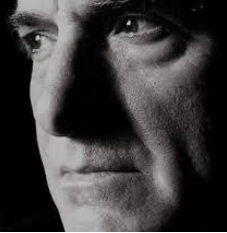

The township of Broken Hill should be world heritage listed. If you haven’t spent a couple of days wandering around its quirky streets and corrugated iron housing then you’re missing out on one of Australia’s best tourism experiences. Not that Australians care – too far from the beach and Michelin stars to be considered worthy of a visit.